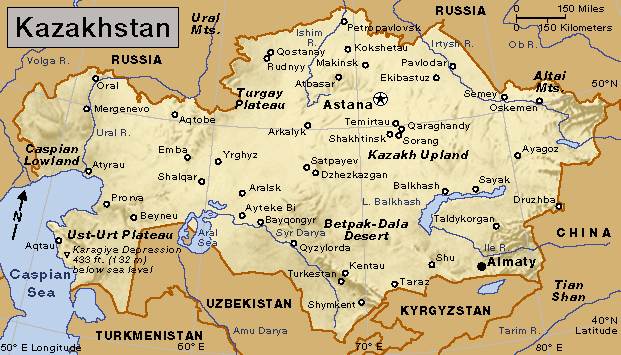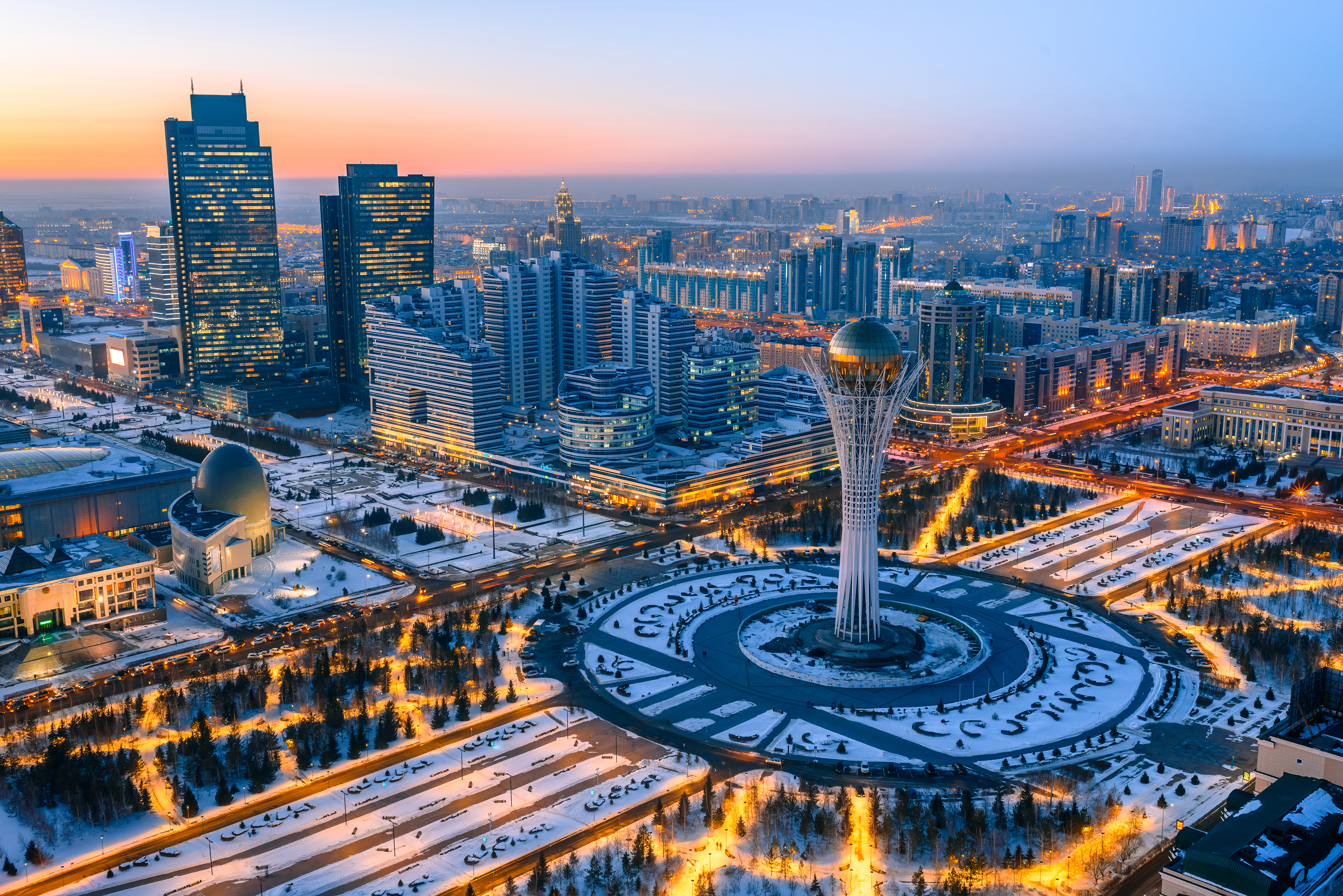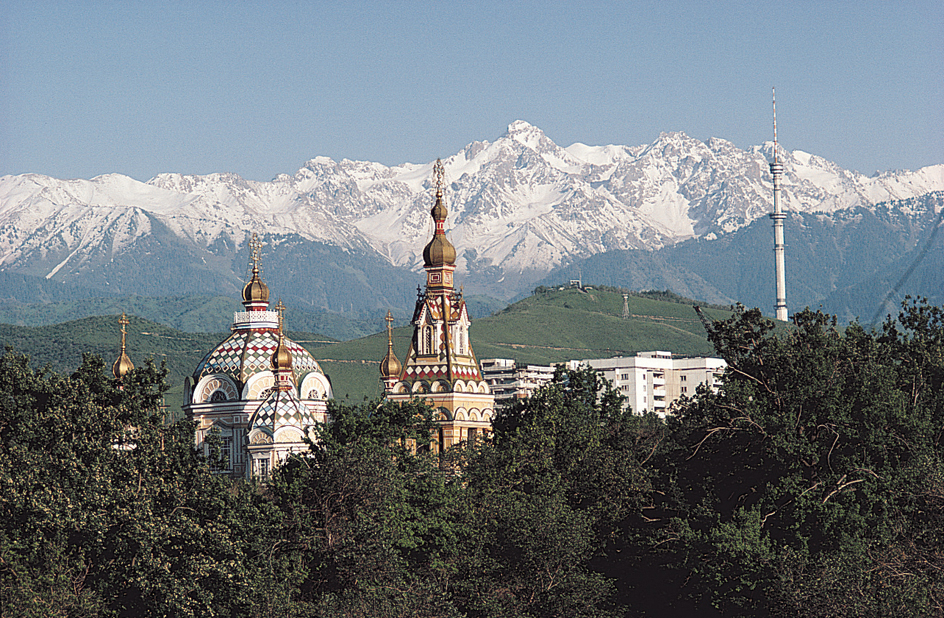Kazakhstan << kah zahk STAHN >> is a country that lies mostly in west-central Asia. A small part of Kazakhstan lies west of the Ural River on the European continent. The country’s name in Kazakh, the official language, is Qazaqstan Respublikasy (Republic of Kazakhstan). The country’s name is also spelled Kazakstan.

Most of the people are Kazakhs or Russians. Astana is the country’s capital. Almaty is its largest city.

For hundreds of years, the Kazakh people were herders who raised their livestock on the region’s plains. They relied on their herds of sheep, camels, cattle, and horses for food, clothing, and transportation. This lifestyle began to change in the 1800’s, when the Russian Empire conquered the Kazakh region. Many Russians settled in the area, greatly reducing the grazing lands.
Kazakhstan became part of the Soviet Union in 1922, when the Soviet Union was formed under Russia’s leadership. During most of the 1900’s, while Kazakhstan was under Soviet rule, industry grew steadily. Meanwhile, most of the Kazakh people ended their nomadic ways and settled in rural villages or cities. In 1991, Kazakhstan declared its independence from the Soviet Union.
Government.
Kazakhstan has a parliamentary government with a strong president. The president serves as head of state and is the most powerful government official. The people elect the president to a five-year term. The president appoints a cabinet to assist in running the government. A prime minister, appointed by parliament and approved by the president, heads the government.
The parliament consists of an upper house called the Senate and a lower house called the Mazhilis. Regional assemblies elect most members of the Senate, but some members are appointed by the president. The people elect most members of the Mazhilis. The remaining members are elected by a presidentially appointed advisory body called the Assembly of People of Kazakhstan. All citizens 18 years old or older may vote.

Kazakhstan is divided into 14 oblasts (provinces) and 4 cities—Almaty, Astana, Bayqongyr, and Shymkent—for purposes of local government. The president appoints a governor to administer each oblast.
The Communist Party was the country’s only political party until 1990. After 1990, other political parties were allowed to form. However, parties do not play an important role in government affairs. By law, parties must have at least 50,000 members to be officially recognized by the government.
Kazakhstan’s highest court is the Supreme Court. The country also has a Constitutional Council and local courts.
Kazakhstan’s armed forces include an army, an air force, and a navy. Kazakhstan also has paramilitary forces, including internal security troops and border protection forces.
People.
Kazakhs make up about 65 percent of the population, and Russians account for about 25 percent. Uzbeks make up about 3 percent of the population. Other ethnic groups in Kazakhstan include Belarusians, Germans, Tatars, Ukrainians, and Uyghurs (also spelled Uighurs). A majority of Kazakhstan’s people, including the Kazakhs, Tatars, Uyghurs, and Uzbeks are Muslims. Most Russians and Belarusians are Orthodox Christians.
Most of the urban people of Kazakhstan live in modern apartments or houses. In the rural villages, most people live in houses. But some Kazakh shepherds still live in traditional tentlike dwellings from their nomadic past. Called yurts, these portable homes are made of a circular wooden frame covered with felt. Most of Kazakhstan’s rural villages do not have running water.
The social life of the Kazakh people is centered around the family. Kazakh men and their children generally remain a part of their parents’ households. Married women become part of the household of their husband’s family. Many women work outside the home as teachers, doctors, and agricultural workers.
The Kazakh people wear both Western-style and traditional clothing. Women generally wear colorful handmade dresses. Most Kazakh men wear Western-style clothing, and some wear traditional felt hats.
Common Kazakh foods include meat dishes and milk products, such as cheese and curds. Besh barmak, thinly sliced meat and noodles boiled in broth, is a popular dish. Kumiss, made from fermented mare’s milk, is a traditional drink. Tea is served at every meal.
The Kazakh people enjoy folk songs and legends, and they recite them for many occasions. At some events, Kazakhs participate in a singing competition called an aitys. The recitation of epics (poems about heroic events) is another important part of Kazakh culture.
Most of Kazakhstan’s Russian people are urban dwellers. The Russian population has maintained its own culture. Performances of Russian ballet, theater, and music take place in all the major cities.
Popular sports in Kazakhstan include volleyball, skating, and wrestling. Kokpar is a traditional Kazakh game in which dozens of skilled horsemen try to carry the carcass of a goat or sheep across a goal.
Kazakh is the country’s official language. Many Kazakhs speak Russian, however, especially urban people. Russian was the official language under Soviet rule. Under the 1995 Constitution, Russian is used on an equal basis with Kazakh in government documents.
Nearly all of Kazakhstan’s people can read and write. The government requires children to attend school from the ages of 6 to 17. The schools use either Kazakh or Russian as the language of instruction. Kazakhstan has many schools of higher learning, including Al-Farabi Kazakh National University and Qaraghandy State University. The country’s National Academy of Sciences includes numerous separate research institutes.
Land and climate.
Kazakhstan’s landscape varies greatly from west to east. In the west, the dry plains of the Caspian lowland border the Caspian Sea. The Karagiye Depression, the country’s lowest point, lies near the Caspian Sea at 433 feet (132 meters) below sea level. Dry lowlands extend over much of the western part of the country and around the Aral Sea on the southwest border.
High, grassy plains called steppes cover large areas of northern Kazakhstan. Sandy deserts extend over much of the south. Northeastern Kazakhstan consists of flat, highly elevated lands that are suitable for farming.
A series of mountain ranges, including the Tian Shan and the Altai Mountains, forms Kazakhstan’s eastern and southeastern borders. Mount Tengri, the highest point, rises 20,991 feet (6,398 meters) in the southeast. Several mountain rivers in the east feed into Lake Balkhash, the largest lake entirely within Kazakhstan. Major rivers include the Ile, the Irtysh, the Syr Darya, and the Ural. 
Kazakhstan has bitterly cold winters and long, hot summers. It receives little rainfall. January temperatures average about 0 °F (-18 °C) in the north and about 23 °F (-5 °C) in the south. July temperatures average about 68 °F (20 °C) in the north and about 81 °F (27 °C) in the south. Average annual rainfall totals only 4 to 16 inches (10 to 40 centimeters). Mountainous regions are colder, and receive more rainfall, than the rest of the country.
Animal life in Kazakhstan varies between the steppes and the desert. Larks, eagles, marmots, tortoises, and squirrels live in the steppes. Gazelles and a variety of rodents and reptiles inhabit the desert. Snow leopards and lynxes live in the mountains.
Economy.
Agriculture’s importance to Kazakhstan’s economy has declined rapidly since Kazakhstan became an independent country in 1991. In 1991, agriculture accounted for over 33 percent of the country’s total economic output. Today, agriculture accounts for only about 5 percent. The country’s major crops include barley, cotton, onions, potatoes, rice, tomatoes, watermelons, and wheat. Farmers raise beef and dairy cattle, chickens, hogs, and sheep.
Manufacturing accounts for about one-tenth of the country’s economic production. Kazakhstan manufactures chemicals, food products, machinery, petroleum products, processed metals, and textiles. Almaty, Pavlodar, Qaraghandy, and Shymkent rank among the chief industrial centers.
Mining plays an important role in Kazakhstan’s economy. Petroleum and natural gas come from fields in western Kazakhstan. Pipelines carry much of the oil and gas across Russian territory to the Black Sea. Coal is mined in central and north-central Kazakhstan. Copper is mined in the central and eastern parts of the country. Kazakhstan’s mines also yield bauxite, chromite, gold, iron, lead, manganese, nickel, phosphate, silver, uranium, and zinc.
Kazakhstan exports much more than it imports. The country’s leading trade partners include China, Germany, Italy, Russia, and Switzerland. Crude oil is Kazakhstan’s leading export. The country also exports chemicals, copper, food, and iron and steel. It imports crude oil and petroleum products, electrical equipment, iron and steel, machinery, and motor vehicles.
Several rail lines connect Kazakhstan’s cities to urban areas in Russia, China, and other neighboring countries. Kazakhstan has a limited system of roads. Almaty, Aqtau, Astana, and Atyra have international airports. The Baykonur Cosmodrome, the former Soviet Union’s main space-launch facility, is near the city of Bayqongyr (formerly Leninsk). Russia uses the facility under a lease agreement with Kazakhstan.
History.
Nomadic people lived in what is now the country of Kazakhstan before the birth of Jesus Christ. Turkic tribes began to settle in the region in the A.D. 700’s. During the 1200’s, Mongols from the east invaded the area and defeated the Turkic people. Many of the country’s people are descended from the Turkic and Mongol tribes.
During the early 1700’s, Russians began migrating to the Kazakh region. In 1731, after suffering attacks from neighboring peoples, the Kazakhs accepted Russian rule for protection. By the mid-1800’s, the Russians had set up forts throughout the Kazakh region. The Russian government took control of vast areas of land and encouraged Russian and Ukrainian peasants to settle in the northern parts of the region. Such efforts greatly reduced Kazakh grazing lands.
A nationalist movement seeking independence from Russia emerged in Kazakhstan following the Russian Revolution of 1917. Kazakh nationalists set up a central government and sent troops to fight against the Bolsheviks, Communists who had seized power in Russia during the Russian Revolution. By late 1919, however, the Kazakh nationalists had sided with the Bolsheviks.
In 1920, the Communists set up Kazakhstan as an autonomous (self-governing) republic. Because Europeans called the Kazakhs Kyrgyz, the republic was called the Kyrgyz Autonomous Soviet Socialist Republic. The present-day Kyrgyz were referred to as the Kara Kyrgyz. The Kazakh republic was renamed the Kazakh Autonomous Soviet Socialist Republic in 1925. The Soviet Union had been formed in 1922 under Russia’s leadership. Kazakhstan became a union republic of the Soviet Union in 1936. It was called the Kazakh Soviet Socialist Republic.
Soviet rule changed many aspects of life. The Soviet Union established a powerful Communist central government in Moscow and took control of all industry and land in Kazakhstan and the other republics. The Communist Party became the only legal political party. Soviet law forbade certain traditional cultural practices, such as religious instruction. But the Soviet government helped develop agriculture and industry. School and health care systems were improved.
During World War II (1939-1945), the Soviet government forced many people from the western part of the Soviet Union to move to Kazakhstan. These people included Germans, Tatars, and Ukrainians.
During the 1950’s, the Soviet government launched a program to expand the use of Kazakhstan’s vast steppes for agriculture. Much of the land was planted with grain. This program, called the Virgin Lands project, brought thousands of people from other parts of the Soviet Union to Kazakhstan.
During the 1980’s, the Soviet government, under Mikhail S. Gorbachev, made reforms toward giving people more freedom. In 1990, Kazakhstan declared that its laws took precedence over those of the Soviet Union. In December 1991, Nursultan Nazarbayev became the first democratically elected president in Kazakh history. On December 16, Kazakhstan declared its independence, just nine days before the Soviet Union broke apart. Kazakhstan joined other Soviet republics in a loose association called the Commonwealth of Independent States.
As an independent country, Kazakhstan replaced its Communist government system with a system based on democratic principles. But in early 1995, President Nazarbayev disbanded the parliament. In an April referendum, voters extended Nazarbayev’s term to 2000. In an August referendum, they approved a new constitution. Members of a new two-house parliament were elected in December 1995. In 1997, Kazakhstan moved its capital from Almaty to the city of Akmola, which it renamed Astana, meaning capital, the following year.
Voters reelected Nazarbayev to the presidency in 1999 and 2005. In 2007, Nazarbayev approved constitutional amendments increasing the size of the country’s parliament, shortening the length of the presidential term, and allowing him to run for an unlimited number of terms in office. Later that year, he disbanded the parliament. In August, voters elected a larger Mazhilis. Nazarbayev was reelected in 2011 and 2015. International monitors criticized these elections as undemocratic and accused Nazarbayev of silencing his critics.
In February 2019, Nazarbayev dismissed the government, claiming that it had failed to grow the country’s economy and raise living standards. He promised increased spending on social programs and greater investment in infrastructure. In March, Nazarbayev announced his retirement. The speaker of Kazakhstan’s Senate, Kassym-Jomart Tokayev, became acting president. The parliament then passed a law to change the name of the nation’s capital from Astana to Nur-Sultan in honor of Nazarbayev. In April, Tokayev called for an early presidential election. Tokayev won the election in June and became president.
In early 2022, the lifting of government controls on fuel prices set off large antigovernment protests. Tokayev asked for and received military assistance from Russia to stop the protests. The protest movement partly blamed Nazarbayev for conditions in Kazakhstan, and the former president’s popularity declined. In September 2022, the parliament changed the name of the capital back to Astana.
